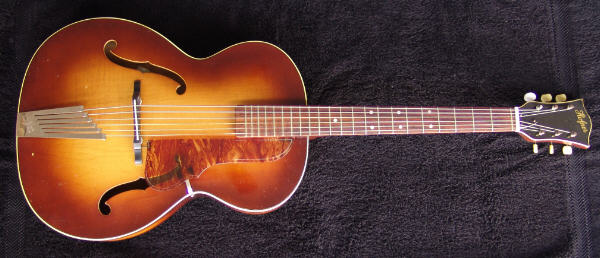


1963 Hofner Congress (Serial No.13308)
The Congress was the "bottom-of-the-range" archtop in the Selmer catalogue throughout the whole of Selmer's distributorship in the UK i.e. between about 1953 and 1972/73. It was Hofner's small body archtop with a body size of 19.5" length x 14.5" or 15" lower bout width x 3" body depth. This size feels quite a lot smaller than Hofner's "standard" body guitars, which had a lower bout width of 16", and consequently the Congress is an easier guitar to play than the likes of the Senator and President. It has almost a "parlour guitar" feel to it, despite it having a full-size 25.5" scale length.
The main features of the Congress, carried across all variants, were:
A plain maple veneer body top, and the use of plain or slightly flamed maple veneers for body back and sides.
Small body size of 19.5" length x 14.5"(initially, with15" later) lower bout width x 3.1" body depth.
Brunette finish only. (Early versions had simple brown staining, with sunburst being adopted from around 1956/57.)
No electric version.
No cutaway.
Only binding to body top. None to body back, f-holes, or neck.
Double dot markers to 5th, 7th, and 9th frets. Single dot marker to 12th fret.
The European/US Market equivalent guitars were the Hofner Model 449, which if anything tended to be even more basic than the Congress.
There was an earlier budget guitar very similar in appearance to the Congress which was marketed by Selmer in the UK up to about 1954/55. This was called the Hofner Square Dance, and it was in-fact the predecessor to the Congress. The same size body as the Congress was used, with the neck joining the body at the 12th fret. However, the top and back of the guitar was flat, rather than arched as with the Congress. Only single dot fret markers were fitted, and the headstock was much more basic than the first Congress models. An even earlier model, called the Hofner Four Square, was produced, and it is assumed that this was actually the predecessor to the Square Dance model.
There are several examples of this model in the Archtops Section of the Visitors' Gallery. In this Fact-File, I have therefore attempted only to describe the features of the Congress at the various stages in its evolution. The headstock and hardware changes are perhaps the most positive method of illustrating the various stages, and hence these are illustrated below.
Please note that, as usual, the evolution described below should only be taken as a guide, and not as 100% gospel. Hofner being Hofner, there was a degree of overlap between the various stages, and not every Congress falls exactly into the pattern.
|
|
|
|
|
|
|
|
|
|
|
|
|
|
|
|
|
|
|
|
|
|
|
|
.jpg)
September 1954 Selmer advertisement featuring the new Hofner Congress, as well as a reference to the new Flamenco model.